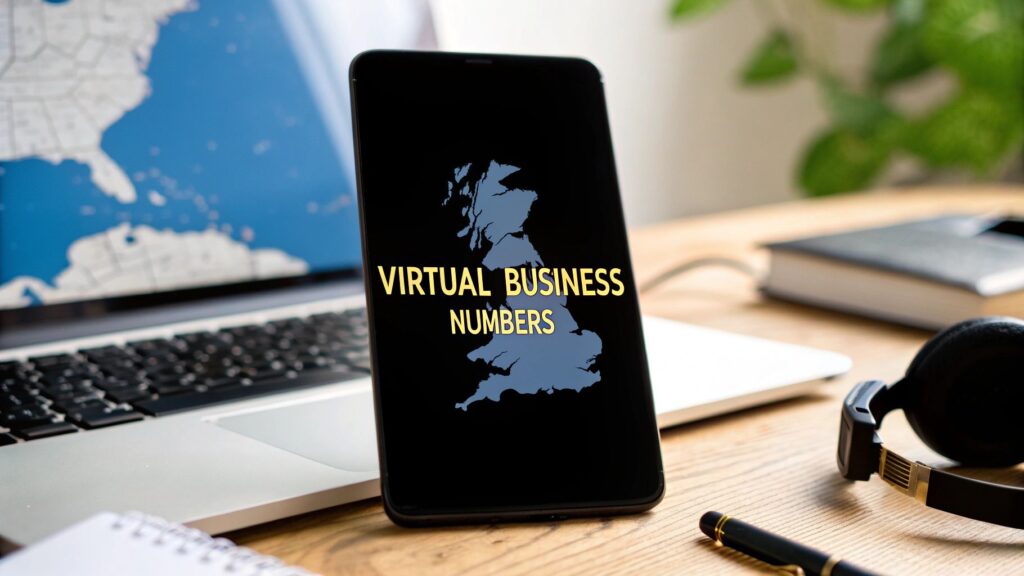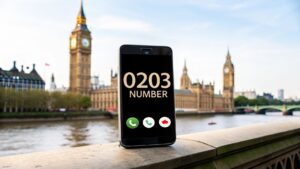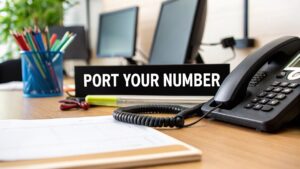Ever wanted a professional business number that rings on your personal mobile, without ever having to give out your private details? That’s exactly what a virtual business number does. It gives your UK business a dedicated, professional line that works with the devices you already own, keeping your work and personal life neatly separated and secure.
What Are Virtual Business Numbers?
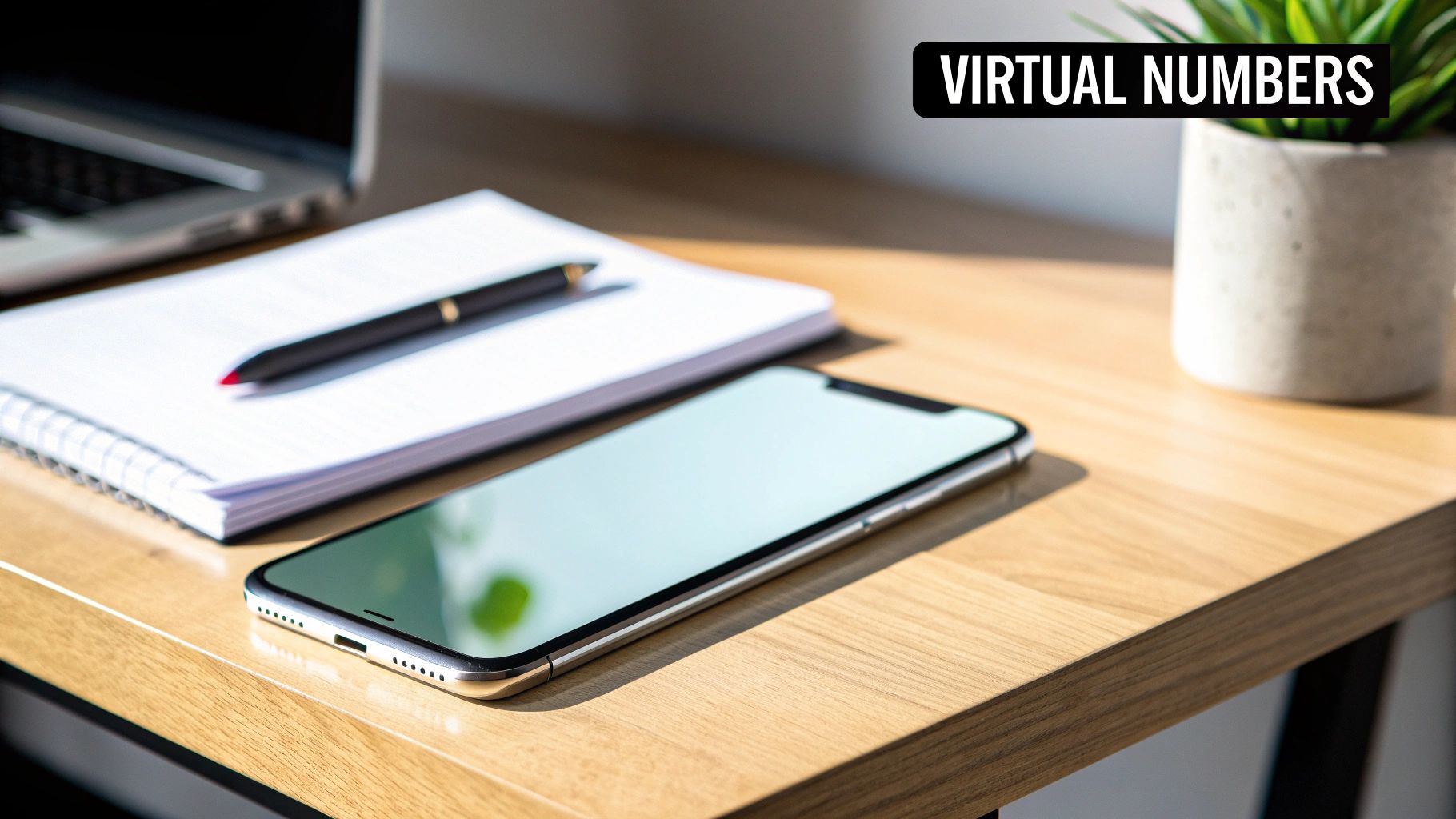
Think of a virtual business number like a professional email address. Just as info@yourcompany.co.uk looks far more credible than daves-plumbing88@hotmail.com, a virtual number projects a polished image while simply forwarding calls to a phone you already use.
It’s essentially a cloud-based phone number that isn’t physically tied to a specific phone line or SIM card. Instead, it uses the internet to route incoming calls to any device you’ve linked to it. This means you could be in your home office in Manchester, a coffee shop in London, or visiting a client in Bristol, and your business line travels with you.
At its core, a virtual number separates your business identity from a physical location. It lets you present a consistent, professional front to your customers, no matter where you are or what device you're using.
This flexibility is a huge advantage for modern UK businesses, especially for freelancers, sole traders, and growing small to medium-sized enterprises (SMEs). It offers a straightforward, affordable way to manage client calls without the cost and hassle of installing a whole new landline system.
How Does It Actually Work?
It’s surprisingly simple. When a customer dials your virtual business number, the call is instantly routed through your provider's network. From there, it's immediately forwarded to one or more 'destination' numbers you've set up in advance.
This forwarding system is incredibly customisable. For example, you can:
- Route calls to multiple devices: Have it ring your mobile first, and if you don't answer after a few rings, it can automatically try your home office phone.
- Set up business hours: Any calls that come in outside your working hours can be sent straight to a professional voicemail greeting.
- Create a national or local presence: You can choose a local area code from anywhere in the UK to build trust in a specific region, or pick a national 0333 number to give the impression of a larger operation.
In a nutshell, virtual business numbers act as an intelligent, flexible switchboard for your existing phones. They empower you to separate your personal and professional lives, boost your brand image, and make sure you never miss an important client call—all through one dedicated number.
Why Your UK Business Needs a Virtual Number

So, you know what a virtual business number is. But the real question is, why should you get one? The answer comes down to practical benefits—from building instant trust with new customers to freeing up cash you can reinvest in your business.
Let’s put it into perspective. Imagine you’re a brilliant web designer based in Bristol, but you want to land clients in the capital. Your local 0117 number might, even subconsciously, make a potential London client hesitate. But what if you had a virtual business number with a London 020 area code? Suddenly, you look like a local player. You’ve broken down a geographical barrier before you've even said hello.
It's a small change, but it completely alters how people perceive your business. It's all about meeting your customers where they are and showing them you're credible from the get-go.
Enhance Your Professional Image
When you're a sole trader or a small business, you're constantly competing with bigger, more established players. How you present yourself matters. A lot. Using your personal mobile for business might seem easy, but it blurs the line between your work and home life, and it doesn't exactly scream 'professional'.
A dedicated virtual number changes that. It instantly makes your business look more polished and established, which is crucial for building trust. When you pair that with professional features like a custom voicemail greeting or a simple menu to direct calls ("Press 1 for sales…"), you're punching well above your weight.
A virtual number gives your one-person operation the polished communication front of a much larger organisation. It levels the playing field, helping you build customer trust from the very first interaction.
This isn't just about looking the part; it directly affects how customers behave. A professional phone setup reassures them they’re dealing with a company that has its act together, making them far more likely to pick up the phone and choose you.
Unmatched Flexibility for Modern Work
Let's be honest, the traditional 9-to-5 in a single office is becoming a thing of the past. We're all working more flexibly, whether that's from home, a co-working space, or a coffee shop. In this world, a landline chained to a physical desk just feels outdated. Virtual business numbers were made for this new way of working.
Your business line is no longer tied to a piece of plastic on a desk. It follows you wherever you go. As long as you have an internet connection, you can take calls on your mobile, your laptop, or any device you're logged into. This agility means you never miss a crucial call and can keep your client communication seamless, no matter where your work takes you.
This flexibility is a lifeline for the UK's small and medium-sized enterprises (SMEs). In 2023, there were around 5.6 million SMEs, making up an incredible 99.9% of all UK businesses. For these companies, tools that reduce overheads and support remote work aren't just a nice-to-have; they're essential for staying competitive. You can dive deeper into the UK's business landscape with these insights from money.co.uk.
Achieve Significant Cost Savings and Scalability
Perhaps the most compelling argument for making the switch is the money you'll save. Traditional landlines are known for hidden costs—pricey installation, monthly line rental, and often the need to buy specific hardware. Virtual numbers get rid of all that.
- No Installation Fees: You're set up online in minutes. No waiting around for an engineer.
- Lower Monthly Costs: Subscription plans are far more affordable than old-school line rental.
- No New Hardware: You simply use the smartphone and computer you already have.
It's not just about immediate savings, either. Virtual numbers are designed to grow with you. When you're just starting out, one number might be all you need. But as you expand and bring on a team, you can add new numbers and set up call routing to different people in an instant, without any disruption. Your phone system scales with you, not against you.
More Than Just a Number: Your Core Communication Tools
A virtual business number isn't just a string of digits; it's the control centre for your entire business communication system. It’s packed with smart tools that solve the real, frustrating problems small businesses face every day. Think of it less as a phone number and more as a clever, automated assistant working for you 24/7.
These features turn a simple contact number into a powerful hub that helps you capture more leads, give customers a better experience, and stay organised. Let's explore the core functions that make this happen and see how they can make a real difference in your day-to-day operations.
Intelligent Call Forwarding: The Heart of Your Flexibility
At its core, call forwarding is the engine that makes a virtual number so powerful. It's the magic that takes an incoming call and sends it to the right person, on the right device, at the right time. This isn't just about bouncing a call from one phone to another; it's about building a smart, custom call flow that fits how you actually work.
You can set up rules that make perfect sense for your business. For example, you could have calls ring your mobile for 15 seconds, and if you don't answer, they automatically reroute to a colleague's phone or your home office line. This simple setup can be a complete game-changer.
- Without It: A potential client calls while you're busy on-site. The call goes to your mobile voicemail. By the time you notice, they've already called a competitor. You've lost a lead.
- With It: The same call comes through to your mobile. You can't answer, so it automatically forwards to your business partner. They pick up, the lead is captured, and the customer gets an instant, professional response.
This visual breakdown really highlights how a virtual number stacks up against a traditional landline. The differences in setup time, cost, and flexibility are stark.
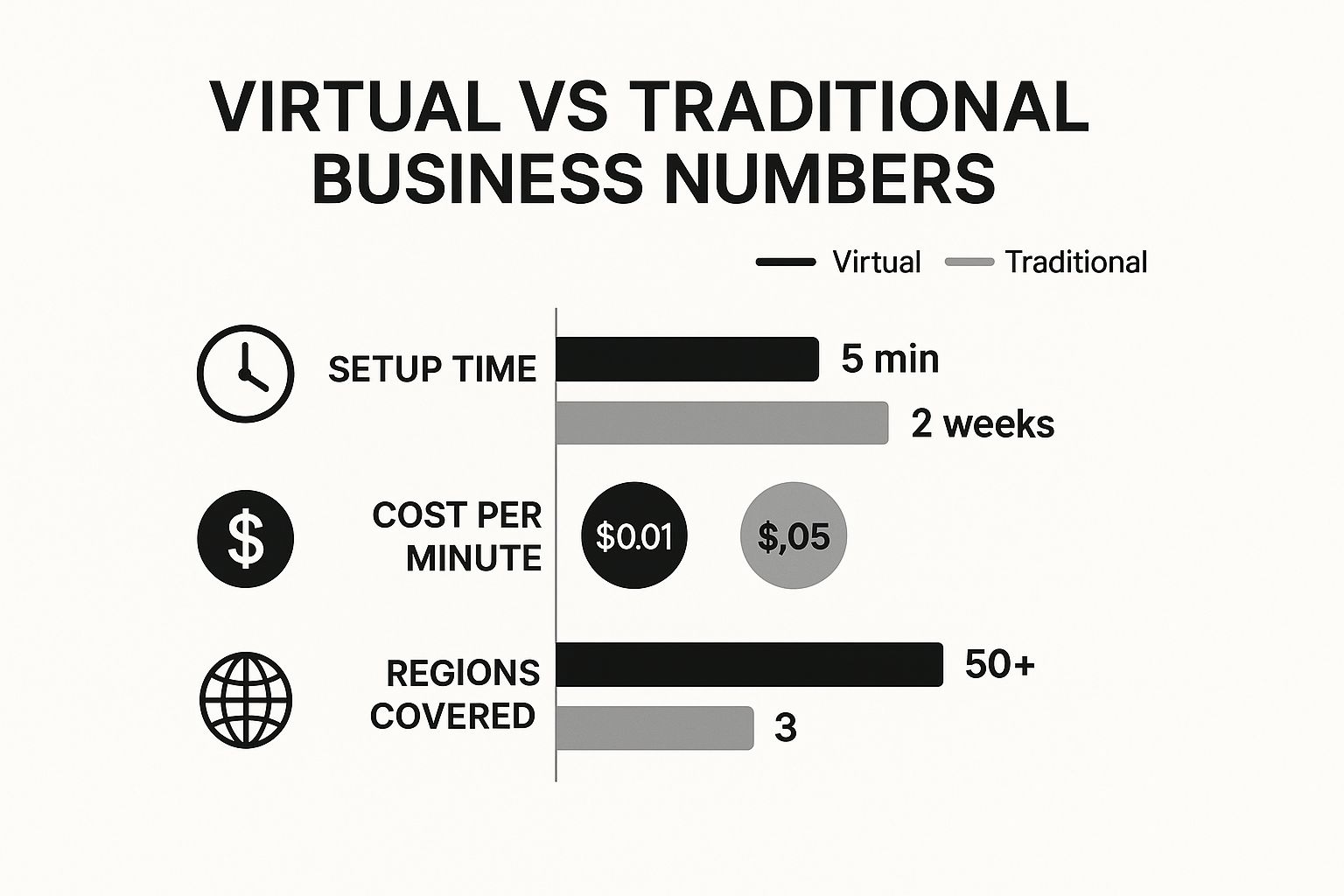
As you can see, the numbers speak for themselves. You can be up and running in minutes at a fraction of the cost, making it a much more efficient choice from day one.
A 24/7 Virtual Receptionist to Greet Your Callers
The auto-attendant (often called an "IVR") acts like a digital receptionist who never sleeps, gets sick, or takes a holiday. It's that professional, automated greeting that answers calls with a custom menu: "Press 1 for sales, Press 2 for support…" This single feature can make a one-person operation sound like a much larger, more established company.
It filters and directs calls exactly where they need to go, so your customers reach the right person without you having to act as a switchboard. It's a massive time-saver for you and creates a seamless, professional journey for every caller.
An auto-attendant ensures every call is answered promptly and professionally, even when you’re out of the office. It guides customers to the right department, improving their experience and boosting your business's credibility.
Never Miss a Beat with Voicemail to Email
We've all been there—so swamped with work that voicemails pile up, unchecked and unanswered. The voicemail-to-email feature is the perfect solution. It takes the audio message, converts it into a digital file, and sends it straight to your email inbox. Some services even provide a text transcription.
This is a huge productivity win. You can scan or listen to messages right from your inbox, prioritise who to call back first, and even forward a voicemail to a team member to handle. It turns a clunky, time-consuming chore into a quick, manageable part of your daily workflow.
Comparing Communication Setups: Traditional vs Virtual
To really grasp the difference, it helps to see a direct comparison. Here's a look at how a virtual business number system stacks up against an old-school business landline.
| Feature | Traditional Landline | Virtual Business Number |
|---|---|---|
| Setup & Installation | Requires an engineer visit, hardware installation, and can take weeks. | Instant online setup, often in minutes, with no physical hardware needed. |
| Cost | High initial setup fees, line rental, and call charges. Expensive to add lines. | Low monthly subscription, often with inclusive minutes. Very affordable to scale. |
| Flexibility | Tied to a single physical location. Difficult to manage calls remotely. | Completely location-independent. Calls can be answered anywhere on any device. |
| Professional Features | Basic features like voicemail are standard, but advanced tools are costly add-ons. | Packed with features like auto-attendant, call recording, and analytics as standard. |
| Scalability | Adding new lines is slow and expensive. Not ideal for a growing business. | Add or remove numbers and users instantly to match your business needs. |
The takeaway is clear: virtual numbers offer a level of agility, affordability, and professional polish that traditional landlines simply can't match in today's business world.
Call Recording for Quality, Training, and Peace of Mind
Call recording is another incredibly useful feature that often comes with virtual business numbers. After getting a caller's consent, you can record conversations for a variety of important reasons. It's a fantastic tool for training new staff, as they can listen back to real customer interactions.
It's also essential for quality assurance, helping you ensure your team is consistently providing top-notch service. And if a dispute or misunderstanding ever arises, having a recording of the conversation provides a clear, objective record. It's a simple feature that adds a vital layer of professionalism and security.
How to Choose the Right UK Provider
Picking a provider for your virtual business number can feel a bit like choosing a new mobile plan—there are so many options, and they all seem to promise the earth. The key is to cut through the marketing noise and focus on what your business actually needs, both now and in the future.
Getting this decision right from the start saves you a world of headaches later, like flaky call quality, hidden fees, or hitting the limits of your plan just as your business takes off. It’s less about just getting a number and more about finding a reliable partner who will support your growth.

The good news is the UK is perfectly set up for this technology. The infrastructure for clear, dependable internet-based communication is incredibly solid, with internet usage at a 97.8% penetration rate as of 2025 and over 88 million mobile connections. This hyper-connected environment is exactly why virtual business numbers have become such a powerful and accessible tool for UK businesses. You can dive deeper into the UK's digital landscape on datareportal.com.
Core Features Versus Nice-to-Haves
First things first: you need to work out what’s essential and what’s just a nice extra. Nearly every provider will offer the basics like call forwarding, but the real value is often in the features included as standard. It’s easy to get lured in by a low headline price, only to find that every useful feature costs extra.
Before you start looking, create a simple checklist of your must-haves. For instance:
- Auto-Attendant: Do you need a virtual receptionist to greet and direct callers?
- Business Hours: Is it vital to automatically route calls to voicemail after 5 pm?
- Call Recording: Do you need to record calls for training, compliance, or quality control?
- Voicemail-to-Email: Would getting voicemails delivered to your inbox save you time?
With your list in hand, comparing providers becomes much easier. You’ll be able to see if you’re paying for tools you will genuinely use, not just a long list of features that sound impressive but don’t solve a real problem for your business.
Evaluating Call Quality and Reliability
Nothing shatters a professional image faster than a crackly, delayed, or frequently dropped call. While the UK’s internet infrastructure is generally robust, the provider's own network and technology play a massive role in call quality. The best providers invest heavily in their tech to ensure you get crystal-clear HD audio on every call.
The reliability of your virtual number is a direct reflection of your business. Consistent, high-quality audio builds trust, while poor connections can make your operation seem amateurish and unreliable.
Look for providers that offer a free trial or a money-back guarantee. There’s no better way to test the service than in your own real-world environment—on your commute, in your home office, or while out at a client's site. Make a few test calls and hear the quality for yourself before you commit.
Scalability and Customer Support
Your business isn't going to stand still, and your phone system shouldn't hold you back. Think about where you want to be in a year or two. Will you be hiring your first employee? Expanding into a new city? The right provider will make it simple to add new numbers, users, and features as your business evolves.
Find out how easy it is to scale your plan. Can you do it yourself in a few clicks from an online dashboard, or is it a long-winded process?
Just as important is the quality of their customer support. When something goes wrong, you need to speak to a responsive, helpful team—ideally one based in the UK. Check their support options. Do they offer phone, email, and live chat? Read reviews from existing customers to get the real story. Great support is a sure sign of a provider that cares about its customers.
Seeing Virtual Numbers in Action
It's one thing to talk about the theory, but where virtual numbers really come to life is when you see them solving real-world problems. Let's look at a few stories from UK businesses that transformed how they work and grew their bottom line—all by adopting a simple, flexible phone number.
Projecting a National Presence
Let’s start with Alex, a freelance management consultant working from her home in Manchester. Alex is an expert in her field, but she faced a common problem: she needed to look like a bigger, more established firm to win high-value corporate clients from across the UK. Using her personal mobile number, with its local 0161 prefix, just wasn't cutting it.
Her solution was a national 0333 number. This simple change instantly removed any geographical ties from her business identity, giving her consultancy a nationwide feel.
- The Challenge: Coming across as a small, localised freelancer.
- The Solution: Switching to a non-geographic 0333 virtual number.
- The Result: Alex immediately gained more credibility with potential clients in London, Birmingham, and Edinburgh. That number, combined with a simple auto-attendant, created the impression of a much larger team, which helped her land bigger contracts.
It was a small tweak to her communication setup, but it completely shifted how clients perceived her. It proves that a virtual number isn't just a tool for answering calls; it’s a powerful branding tool.
Building Local Trust to Grow an E-commerce Brand
Next, picture an online boutique that sells handmade gifts. The brand was doing well nationally but was finding it hard to convert shoppers in key cities like Leeds and Glasgow. Their data showed that people in those areas were hesitant to buy from a business that seemed distant and unfamiliar.
To close that gap, the owner set up local virtual numbers for each target city. A Leeds 0113 number appeared on ads aimed at Yorkshire, while a Glasgow 0141 number was used for all their Scottish promotions.
By offering a local contact number, the e-commerce brand broke down the psychological barrier of distance. Customers felt they were dealing with a nearby business, which significantly increased their trust and willingness to buy.
This strategy is especially powerful in the UK's massive e-commerce market. With nearly 60 million of us shopping online in 2023, standing out means building a genuine connection. Giving customers a local number reassures them that help is just a familiar phone call away—a simple tactic that's brilliant for boosting regional sales. You can dig into more fascinating figures on UK e-commerce trends at spaceandtime.co.uk.
Managing Enquiries on the Go
Finally, think about a plumber named Ben. Ben is a master at his trade, but he was drowning in calls while trying to get work done. Every call he missed was a potential job lost, but answering his phone while under a sink was both unprofessional and impractical.
Ben’s game-changer was a virtual number linked to an auto-attendant. Now when customers call, they get a professional greeting: "Thanks for calling Ben's Plumbing. For new job enquiries, press 1. For existing appointments, press 2."
This simple system completely reorganised his day:
- Filtered Calls: Non-urgent messages were sent to voicemail, which he could check between jobs.
- Captured Leads: Urgent calls were forwarded straight to his mobile, so he never missed a big job.
- Enhanced Professionalism: Every caller got a prompt, organised response, making his one-man operation sound as efficient as a much bigger firm.
Suddenly, Ben could focus on the job at hand, knowing his virtual receptionist was busy lining up his next one. It’s a perfect illustration of how virtual business numbers help small businesses work smarter, not harder.
Setting Up Your Virtual Number Step-by-Step
Getting a virtual business number up and running is surprisingly quick and painless. Forget the old days of waiting for an engineer to install a new phone line. Most of the time, you can get everything sorted online in less time than it takes to make a cup of tea.
This guide will walk you through the three simple stages to get your new number live, so you can feel confident making the right choices for your business.
Step 1: Choose Your Number Type
First, you need to decide what kind of number you want. This isn’t just a random set of digits; the type of number you choose sends a clear signal to your customers. In the UK, you have three main options.
- Local Numbers: These start with a familiar area code, like 020 for London or 0161 for Manchester. They're brilliant for building local trust and making your business feel part of the community.
- National Numbers: A number starting with 0333 isn't tied to any specific city. This makes it a great option for businesses with a nationwide customer base, giving you the feel of a larger, established company.
- Freephone Numbers: With an 0800 or 0808 number, your customers can call you for free. It’s a powerful way to encourage more enquiries and show you put your customers first.
Step 2: Select a Provider
Once you know the type of number you need, it's time to pick a provider. This is an important decision, as you're choosing a partner to handle a vital part of your business communications. Revisit that checklist from the last section to weigh up your options based on call quality, features, and customer support.
A good provider will make this part easy. You should be able to sign up on their website, pick out your number, and get going within minutes. Don’t forget that reliability is key, so look for a service with solid customer reviews and straightforward pricing.
Step 3: Configure Your Call Settings
Now for the fun part. This is where you tell your new virtual number exactly what to do with incoming calls. You’ll do all of this from a simple online dashboard, tailoring the settings to match how your business works.
Think of this as programming your own virtual receptionist. You’re setting the rules so every call is handled perfectly, even when you can’t get to the phone yourself.
To get started, focus on these essentials:
- Set Up Call Forwarding: Enter the destination number (or numbers) where you want calls to ring. This could be your mobile, an office landline, or a team member’s phone.
- Record a Voicemail Greeting: Take a moment to record a professional voicemail message. It’s your safety net for missed calls and another chance to make a great first impression.
- Establish Business Hours: Let the system know when you’re open. Any calls that come in outside of these hours can be sent straight to voicemail automatically.
With those basics covered, your virtual business number is officially live. You can always dive back into the settings later to tweak things or add more advanced features like an auto-attendant as your business grows.
Frequently Asked Questions
Even with a good grasp of how virtual business numbers work, you probably still have a few practical questions. Let's get them answered so you can feel confident about making the switch.
Can I Keep My Existing Business Number?
Yes, absolutely. The process is called 'number porting', and it’s a standard service offered by most UK providers. They essentially lift your existing landline or mobile number and move it over to their virtual system.
This is a huge plus because you get all the benefits of a modern phone system without having to change your number and update all your customers and marketing materials. Your provider handles all the technical details, making the transition smooth and hassle-free.
Is the Call Quality as Good as a Landline?
Yes, it is. Modern virtual number services run on Voice over Internet Protocol (VoIP) technology, and the quality is often crystal clear—just like a traditional landline. The only real requirement is a decent internet connection.
If you have reliable broadband at the office or a solid mobile data signal, your calls will be sharp and professional. Providers have invested heavily in their networks to guarantee high-definition audio, so poor quality is rarely an issue.
It's a bit like streaming a film on Netflix. As long as your internet connection is stable, you get a perfect, high-definition picture. The same principle applies here; a good connection means flawless call quality.
What’s the Typical Cost in the UK?
This is one of the best parts – it's far more affordable than a traditional business line. You're not paying for line installation, monthly rentals, or any clunky hardware.
For a freelancer or small business, plans often start from as little as £5 to £15 per month. The final price usually depends on a couple of things:
- The type of number: A standard local number is usually the cheapest option. A freephone number might cost a little more.
- The features you need: The price will shift depending on what’s included, like your call minute allowance, call recording, or a virtual receptionist.
Ultimately, you’re getting the kind of powerful features you’d expect from a big corporate phone system at a price that actually works for a small business.
Ready to look more professional and draw a clear line between work and home in less than five minutes? Join thousands of UK entrepreneurs who trust Business Numbers Direct. Get your dedicated virtual number for WhatsApp Business and take control of your communications today. Get started for just £7.99 a month.

